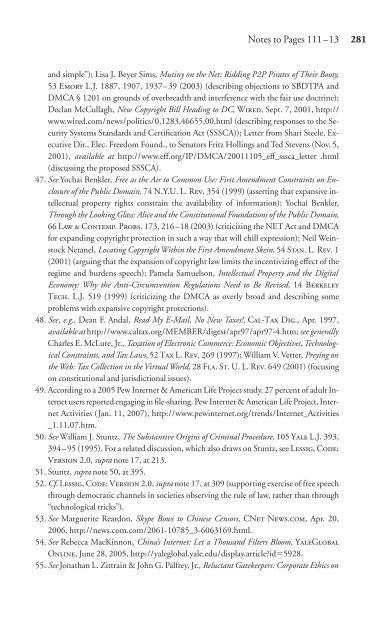Download - Future of the Internet â And how to stop it.
Download - Future of the Internet â And how to stop it.
Download - Future of the Internet â And how to stop it.
You also want an ePaper? Increase the reach of your titles
YUMPU automatically turns print PDFs into web optimized ePapers that Google loves.
Notes <strong>to</strong> Pages 111–13 281<br />
and simple”); Lisa J. Beyer Sims, Mutiny on <strong>the</strong> Net: Ridding P2P Pirates <strong>of</strong> Their Booty,<br />
53 EMORY L.J. 1887, 1907, 1937–39 (2003) (describing objections <strong>to</strong> SBDTPA and<br />
DMCA § 1201 on grounds <strong>of</strong> overbreadth and interference w<strong>it</strong>h <strong>the</strong> fair use doctrine);<br />
Declan McCullagh, New Copyright Bill Heading <strong>to</strong> DC, WIRED, Sept. 7, 2001, http://<br />
www.wired.com/news/pol<strong>it</strong>ics/0,1283,46655,00.html (describing responses <strong>to</strong> <strong>the</strong> Secur<strong>it</strong>y<br />
Systems Standards and Certification Act (SSSCA)); Letter from Shari Steele, Executive<br />
Dir., Elec. Freedom Found., <strong>to</strong> Sena<strong>to</strong>rs Fr<strong>it</strong>z Hollings and Ted Stevens (Nov. 5,<br />
2001), available at http://www.eff.org/IP/DMCA/20011105_eff_sssca_letter .html<br />
(discussing <strong>the</strong> proposed SSSCA).<br />
47. See Yochai Benkler, Free as <strong>the</strong> Air <strong>to</strong> Common Use: First Amendment Constraints on Enclosure<br />
<strong>of</strong> <strong>the</strong> Public Domain, 74 N.Y.U. L. REV. 354 (1999) (asserting that expansive intellectual<br />
property rights constrain <strong>the</strong> availabil<strong>it</strong>y <strong>of</strong> information); Yochai Benkler,<br />
Through <strong>the</strong> Looking Glass: Alice and <strong>the</strong> Const<strong>it</strong>utional Foundations <strong>of</strong> <strong>the</strong> Public Domain,<br />
66 LAW & CONTEMP. PROBS. 173, 216–18 (2003) (cr<strong>it</strong>icizing <strong>the</strong> NET Act and DMCA<br />
for expanding copyright protection in such a way that will chill expression); Neil Weins<strong>to</strong>ck<br />
Netanel, Locating Copyright W<strong>it</strong>hin <strong>the</strong> First Amendment Skein, 54 STAN. L. REV. 1<br />
(2001) (arguing that <strong>the</strong> expansion <strong>of</strong> copyright law lim<strong>it</strong>s <strong>the</strong> incentivizing effect <strong>of</strong> <strong>the</strong><br />
regime and burdens speech); Pamela Samuelson, Intellectual Property and <strong>the</strong> Dig<strong>it</strong>al<br />
Economy: Why <strong>the</strong> Anti-Circumvention Regulations Need <strong>to</strong> Be Revised, 14 BERKELEY<br />
TECH. L.J. 519 (1999) (cr<strong>it</strong>icizing <strong>the</strong> DMCA as overly broad and describing some<br />
problems w<strong>it</strong>h expansive copyright protections).<br />
48. See, e.g., Dean F. <strong>And</strong>al, Read My E-Mail, No New Taxes!, CAL-TAX DIG., Apr. 1997,<br />
available at http://www.caltax.org/MEMBER/digest/apr97/apr97-4.htm; see generally<br />
Charles E. McLure, Jr., Taxation <strong>of</strong> Electronic Commerce: Economic Objectives, Technological<br />
Constraints, and Tax Laws, 52 TAX L. REV. 269 (1997); William V. Vetter, Preying on<br />
<strong>the</strong> Web: Tax Collection in <strong>the</strong> Virtual World, 28 FLA. ST. U. L. REV. 649 (2001) (focusing<br />
on const<strong>it</strong>utional and jurisdictional issues).<br />
49. According <strong>to</strong> a 2005 Pew <strong>Internet</strong> & American Life Project study, 27 percent <strong>of</strong> adult <strong>Internet</strong><br />
users reported engaging in file-sharing. Pew <strong>Internet</strong> & American Life Project, <strong>Internet</strong><br />
Activ<strong>it</strong>ies (Jan. 11, 2007), http://www.pewinternet.org/trends/<strong>Internet</strong>_Activ<strong>it</strong>ies<br />
_1.11.07.htm.<br />
50. See William J. Stuntz, The Substantive Origins <strong>of</strong> Criminal Procedure, 105 YALE L.J. 393,<br />
394–95 (1995). For a related discussion, which also draws on Stuntz, see LESSIG, CODE:<br />
VERSION 2.0, supra note 17, at 213.<br />
51. Stuntz, supra note 50, at 395.<br />
52. Cf. LESSIG, CODE: VERSION 2.0, supra note 17, at 309 (supporting exercise <strong>of</strong> free speech<br />
through democratic channels in societies observing <strong>the</strong> rule <strong>of</strong> law, ra<strong>the</strong>r than through<br />
“technological tricks”).<br />
53. See Marguer<strong>it</strong>e Reardon, Skype Bows <strong>to</strong> Chinese Censors, CNET NEWS.COM, Apr. 20,<br />
2006, http://news.com.com/2061-10785_3-6063169.html.<br />
54. See Rebecca MacKinnon, China’s <strong>Internet</strong>: Let a Thousand Filters Bloom, YALEGLOBAL<br />
ONLINE, June 28, 2005, http://yaleglobal.yale.edu/display.articleid5928.<br />
55. See Jonathan L. Z<strong>it</strong>train & John G. Palfrey, Jr., Reluctant Gatekeepers: Corporate Ethics on


